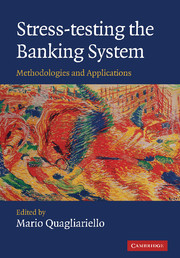Book contents
- Frontmatter
- Contents
- List of figures
- List of tables
- List of boxes
- List of contributors
- Foreword
- Acknowledgements
- Introduction
- Part I Fundamentals
- 1 A framework for assessing financial stability
- 2 Macroeconomic stress-testing: definitions and main components
- 3 Macroeconomic stress-testing banks: a survey of methodologies
- 4 Scenario design and calibration
- 5 Risk aggregation and economic capital
- 6 Data needs for stress-testing
- 7 Use of macro stress tests in policy-making
- Part II Applications
- Conclusions
- Index
- References
3 - Macroeconomic stress-testing banks: a survey of methodologies
from Part I - Fundamentals
Published online by Cambridge University Press: 18 December 2009
- Frontmatter
- Contents
- List of figures
- List of tables
- List of boxes
- List of contributors
- Foreword
- Acknowledgements
- Introduction
- Part I Fundamentals
- 1 A framework for assessing financial stability
- 2 Macroeconomic stress-testing: definitions and main components
- 3 Macroeconomic stress-testing banks: a survey of methodologies
- 4 Scenario design and calibration
- 5 Risk aggregation and economic capital
- 6 Data needs for stress-testing
- 7 Use of macro stress tests in policy-making
- Part II Applications
- Conclusions
- Index
- References
Summary
Introduction
As discussed in previous chapters, macroeconomic stress tests have become an essential component of authorities' toolsets to analyse financial stability. This chapter reviews current methodologies of top-down macro stress tests focusing on banks.Figure 3.1 summarises the model structure of macro stress tests.
As Summer (2007) points out, this structure is essentially rooted in the quantitative risk management framework (McNeil et al., 2005), which also underpins banks' risk management models.
From a modelling perspective the starting point of the quantitative risk management framework is risk exposures. In the context of macro stress tests this could be the total risk exposures of the banking system in a country. It is assumed that the value of these exposures at a future date T is driven by a set of exogenous systematic risk factors such as interest rates or gross domestic product (GDP). The main part of the stress-testing model embodies the data-generating process which captures the interdependence of different risk factors between each other and across time. Finally, by modelling the impact of systematic risk drivers on exposures at time T the model allows the calculation of risk measures such as value-at-risk (VaR) or profitability. Once the model is in place, different stress test scenarios can be run.
Before discussing this modular stress testing structure in more detail, it is worth noting that, as any other model, stress tests can only capture reality in a stylised fashion.
- Type
- Chapter
- Information
- Stress-testing the Banking SystemMethodologies and Applications, pp. 37 - 67Publisher: Cambridge University PressPrint publication year: 2009
References
- 23
- Cited by



